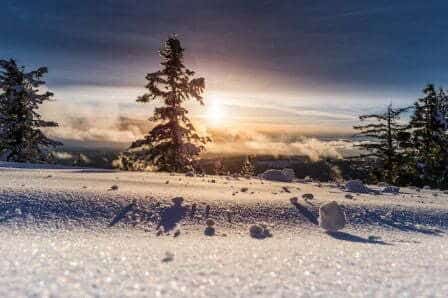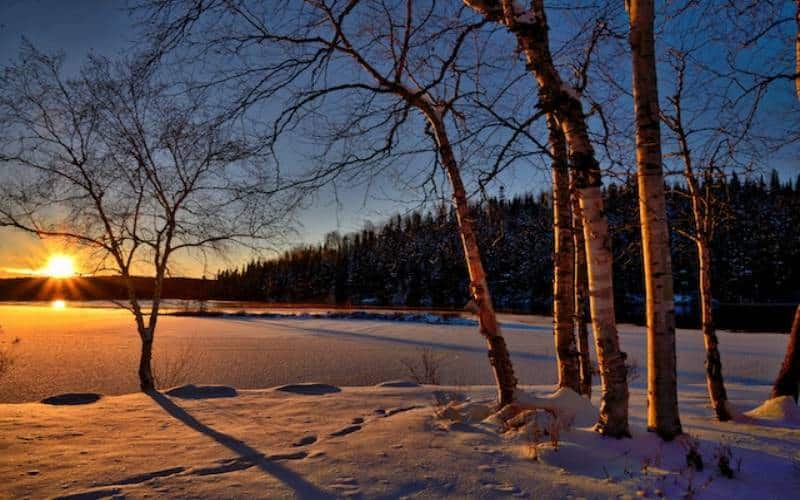The Winter Solstice is a magical season, one that marks the journey from this year to the next, journeys of the spirit from one world to the next, and the magic of birth, death, and rebirth. The longest night of the year (December 21 in the Northern hemisphere) is reborn as the start of the solar year and accompanied by festivals of light to mark the rebirth of the Sun.
In ancient Europe, this night of darkness grew from the myths of the Norse goddess Frigga who sat at her spinning wheel weaving the fates, and the celebration was called Yule, from the Norse word Jul, meaning wheel. The Christmas wreath, a symbol adapted from Frigga’s “Wheel of Fate,” reminds us of the cycle of the seasons and the continuity of life.
Christianity and Winter Solstice

That the timing of the Christian celebration of the birth of Christ occurs in the Yule season is no coincidence. Christmas was once a movable feast, celebrated many different times during the year.
The decision to establish December 25the “official” date of Christ’s birth was made in the fourth century AD. Hoping to replace the pagan celebration with the Christian one . All because this date coincided with the pagan celebrations of Winter Solstice. Marking the Return of the Sun Gods occurring throughout the world.
Yule Festival
Numerous Christmas traditions derive from earlier pagan celebrations. Yule, celebrating the birth or rebirth of a god of light, made use of fire, both in candles and the burning of a Yule log. The Christmas tree has its origins in the practice of bringing a live tree into the home. This was done so that the wood spirits would have a place to keep warm during the cold winter months.
Bells were hung in the limbs so you could tell when an appreciative spirit was present. Food and treats were hung on the branches for the spirits to eat, and a five-pointed star, the pentagram, the symbol of the five elements, was placed atop the tree.
Winter Solstice And Its Role In Numerous Religions
Winter Solstice was a significant date for many cultures, spanning many countries, continents, and time periods. As such, it makes no wonder that many gods and goddesses were born or gave birth on that day.
Frigga and Winter Solstice
In Northern Europe, the year’s longest night is called “Mother Night”. It was in darkness the goddess Frigga labored to bring the Light to birth once more. The Young Sun, Baldur, who controlled the sun and rain and brought fruitfulness to the fields, was born. Frigga’s blessing is invoked for all birthing women. Lighing a white candle that last burned on the solstice is a charm to provide a safe delivery.
Mistletoe and Its Connection to Winter Solstice
The mistletoe’s association with the holidays comes from the myths of the goddess Frigga. The plant’s white berries were formed from Frigga’s tears of mourning when her beloved son Baldur was killed by a dart made from mistletoe.
Some versions of the story of Baldur’s death end happily. Baldur is restored to life, and the goddess is so grateful that she reverses the reputation of the baleful plant. Thus making it a symbol of peace and love and promising a kiss to all who pass under it.
Isis, Horus, and Winter Solstice
The Egyptian goddess Isis delivered Horus, whose symbol was the winged Sun. She conceived Horus with her brother Osiris, who was brutally killed by their brother Set.

Just like the winter solstice as a day with the least sun symbolizes the incoming warmer and sunnier days, the birth of Horus symbolizes happier days after all the sorrow that came with Osiris’ death. Just like the sun was weak at that time, Horus was born prematurely. He might have been imperfect, but as he matured, he grew stronger and more powerful.
Additionally, this is the time of the year when the Isis Star, most commonly known as Sirius, reaches its highest point in the sky. Sirius is also the shiniest star that we can see from the Earth.
Some other deities shared the same “birthday” with Horus. For example, Mithras, the Unconquered Sun of Persia, was born during the solstice.
Amaterasu
Amaterasu, the Japanese Goddess of the Sun, was deeply disturbed after her brother Susano-o defiled her temple. Killing a horse and dumping its carcass into the weaving room where Amaterasu’s worshippers were working.
As a result, Amaterasu went to a dark cave in the mountains,. There she hid from everyone and went into a depressed state. Since she was the Goddess of the Sun, with her gone, there was no light and warmth on Earth. Crops started to fail, and people were starving in the eternal night.
Other gods and deities tried to pull Amaterasu out of her state, but no one could do it. Not until Ame-no-Uzume danced frantically and made Amaterause come out of her cave. This happened on the day of Winter Solstice. A day that will be connected to the return of the sun from now on.
Rhea gave birth to Saturn, son of the Father of Time. Hera conceived Hephaestus the Olympian god of fire, and Quetzalcoatl and Lucina (“Little Light”) also celebrate birthdays at this time. Lucia, saint or Goddess of Light, is honored from Italy to Sweden, crowned with candles to carry us through the darkness. The birth of Saraswati, the Hindu goddess of knowledge and the Queen of Heaven, is also celebrated during Yule-tide.
Rhiannon and Winter Solstice
Finally, Winter Solstice is a time for visions. During that night, Rhiannon, a Welsh incarnation of Epona, the Celtic Mare Goddess, rides through the dreams of her people . Transporting them to the place between the worlds.
There, they can create their own visions, giving them a gift of what they need most, helping them to make real their dreams. In Scotland, the last night of the year is Wish Night. This is a holiday when wishes made for the coming year are at their most powerful.
Winter Solstice As a Symbol of the Incoming Abundance
The Solstice is also a time of plenty. The Hopi Kachinas return to the Earth during the solstice, and the Deer Mothers dance for the earth’s fertility. The hearth fires of Hestia (known as the Roman goddess Vesta) are quenched and then rekindled. The “first fruits” festival, Kwanzaa, is held to honor the seven major deities of Yoruba.
Other Goddesses
If you enjoyed this post we are sure you will enjoy getting to know some of the other goddesses we also write about. You can find the complete list of goddesses sorted across regions and religions here.


